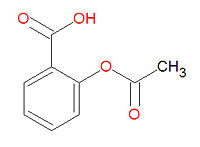Aspirin: Difference between revisions
imported>David E. Volk mNo edit summary |
imported>David E. Volk mNo edit summary |
||
| Line 1: | Line 1: | ||
{{subpages}} | |||
[[Image:Aspirin structure.jpg|right|thumb|200px|{{#ifexist:Template:Aspirin structure.jpg/credit|{{Aspirin structure.jpg/credit}}<br/>|}}Aspirin.]] | [[Image:Aspirin structure.jpg|right|thumb|200px|{{#ifexist:Template:Aspirin structure.jpg/credit|{{Aspirin structure.jpg/credit}}<br/>|}}Aspirin.]] | ||
'''Aspirin''', or '''acetylsalicylic acid,''' is the "prototypical analgesic used in the treatment of mild to moderate [[pain]]. It has anti-inflammatory and antipyretic properties and acts as an inhibitor of [[cyclooxygenase]] which results in the inhibition of the biosynthesis of [[prostaglandin]]s. Specifically, it inactivates the enzyme [[prostaglandin synthase]] by acetylating its terminal amino group. Aspirin also inhibits [[platelet]] aggregation and is used in the prevention of arterial and venous [[thrombosis]]."<ref>{{MeSH}}</ref> | '''Aspirin''', or '''acetylsalicylic acid,''' is the "prototypical analgesic used in the treatment of mild to moderate [[pain]]. It has anti-inflammatory and antipyretic properties and acts as an inhibitor of [[cyclooxygenase]] which results in the inhibition of the biosynthesis of [[prostaglandin]]s. Specifically, it inactivates the enzyme [[prostaglandin synthase]] by acetylating its terminal amino group. Aspirin also inhibits [[platelet]] aggregation and is used in the prevention of arterial and venous [[thrombosis]]."<ref>{{MeSH}}</ref> Aspirin is a [[non-steroidal antiflammatory drug]], often abbreviates as NSAID. | ||
Aspirin resistance may cause susceptibility to cardiovascular morbidity.<ref>Krasopoulos, George et al. 2008. “Aspirin "resistance" and risk of cardiovascular morbidity: systematic review and meta-analysis.” BMJ 336(7637):195-198. http://www.bmj.com/cgi/content/full/336/7637/195</ref> | Aspirin resistance may cause susceptibility to cardiovascular morbidity.<ref>Krasopoulos, George et al. 2008. “Aspirin "resistance" and risk of cardiovascular morbidity: systematic review and meta-analysis.” BMJ 336(7637):195-198. http://www.bmj.com/cgi/content/full/336/7637/195</ref> | ||
Revision as of 09:43, 10 May 2008
Aspirin, or acetylsalicylic acid, is the "prototypical analgesic used in the treatment of mild to moderate pain. It has anti-inflammatory and antipyretic properties and acts as an inhibitor of cyclooxygenase which results in the inhibition of the biosynthesis of prostaglandins. Specifically, it inactivates the enzyme prostaglandin synthase by acetylating its terminal amino group. Aspirin also inhibits platelet aggregation and is used in the prevention of arterial and venous thrombosis."[1] Aspirin is a non-steroidal antiflammatory drug, often abbreviates as NSAID.
Aspirin resistance may cause susceptibility to cardiovascular morbidity.[2]
Aspirin resistance
Individuals in whom platelet function assays demonstrate resistance to aspirin are less likely to have cardiovascular protection from aspirin or other antiplatelet treatments.[3] As many as 28% of patients are resistant to aspirin.[3]
External links
- Aspirin - FDA approved drug information (drug label) from DailyMed (U.S. National Library of Medicine).
- Template:MedMaster
- Template:DrugBank
References
- ↑ Anonymous (2024), Aspirin (English). Medical Subject Headings. U.S. National Library of Medicine.
- ↑ Krasopoulos, George et al. 2008. “Aspirin "resistance" and risk of cardiovascular morbidity: systematic review and meta-analysis.” BMJ 336(7637):195-198. http://www.bmj.com/cgi/content/full/336/7637/195
- ↑ 3.0 3.1 Krasopoulos G, Brister SJ, Beattie WS, Buchanan MR (2008). "Aspirin "resistance" and risk of cardiovascular morbidity: systematic review and meta-analysis". BMJ 336 (7637): 195–8. DOI:10.1136/bmj.39430.529549.BE. PMID 18202034. Research Blogging.
